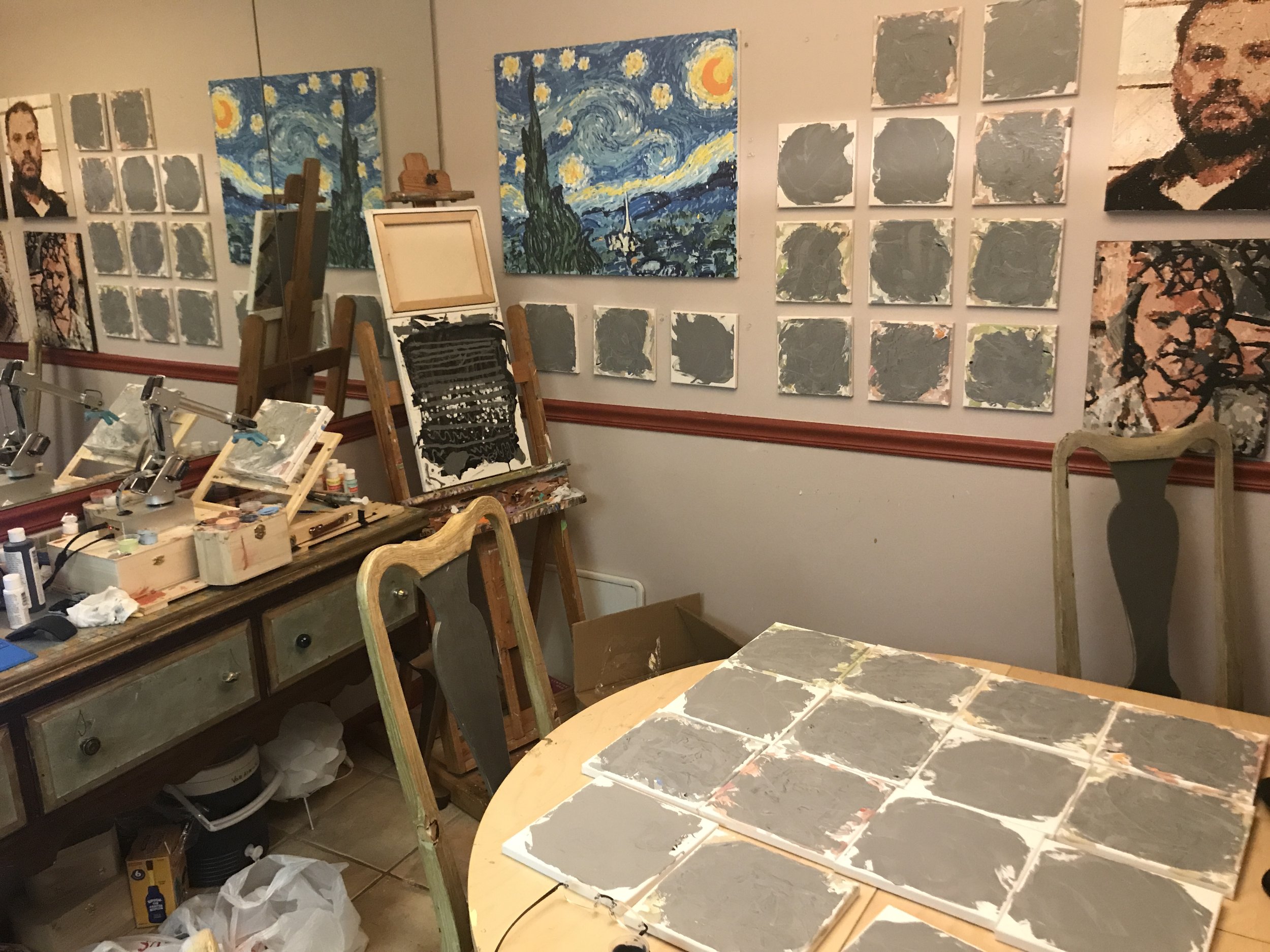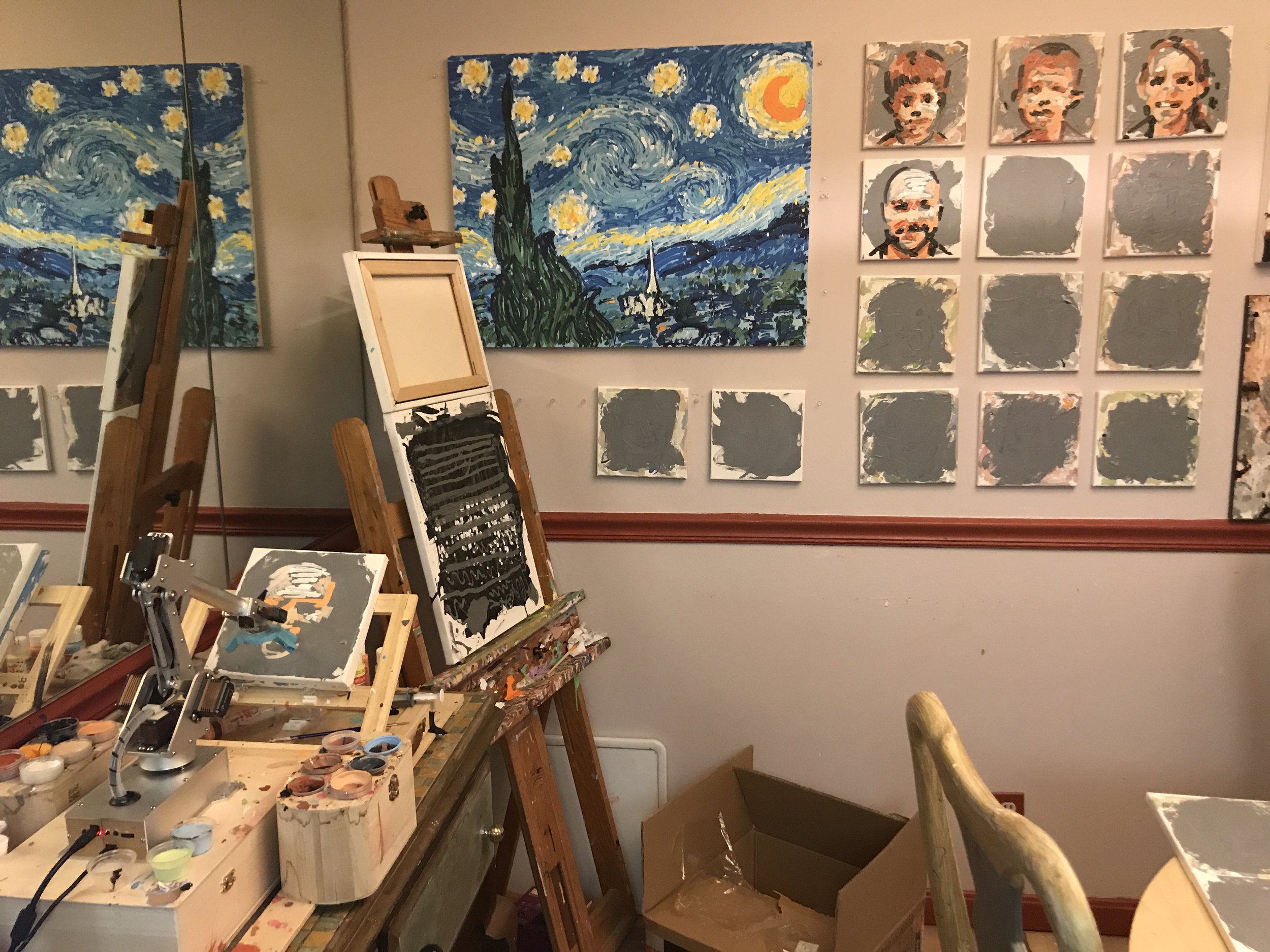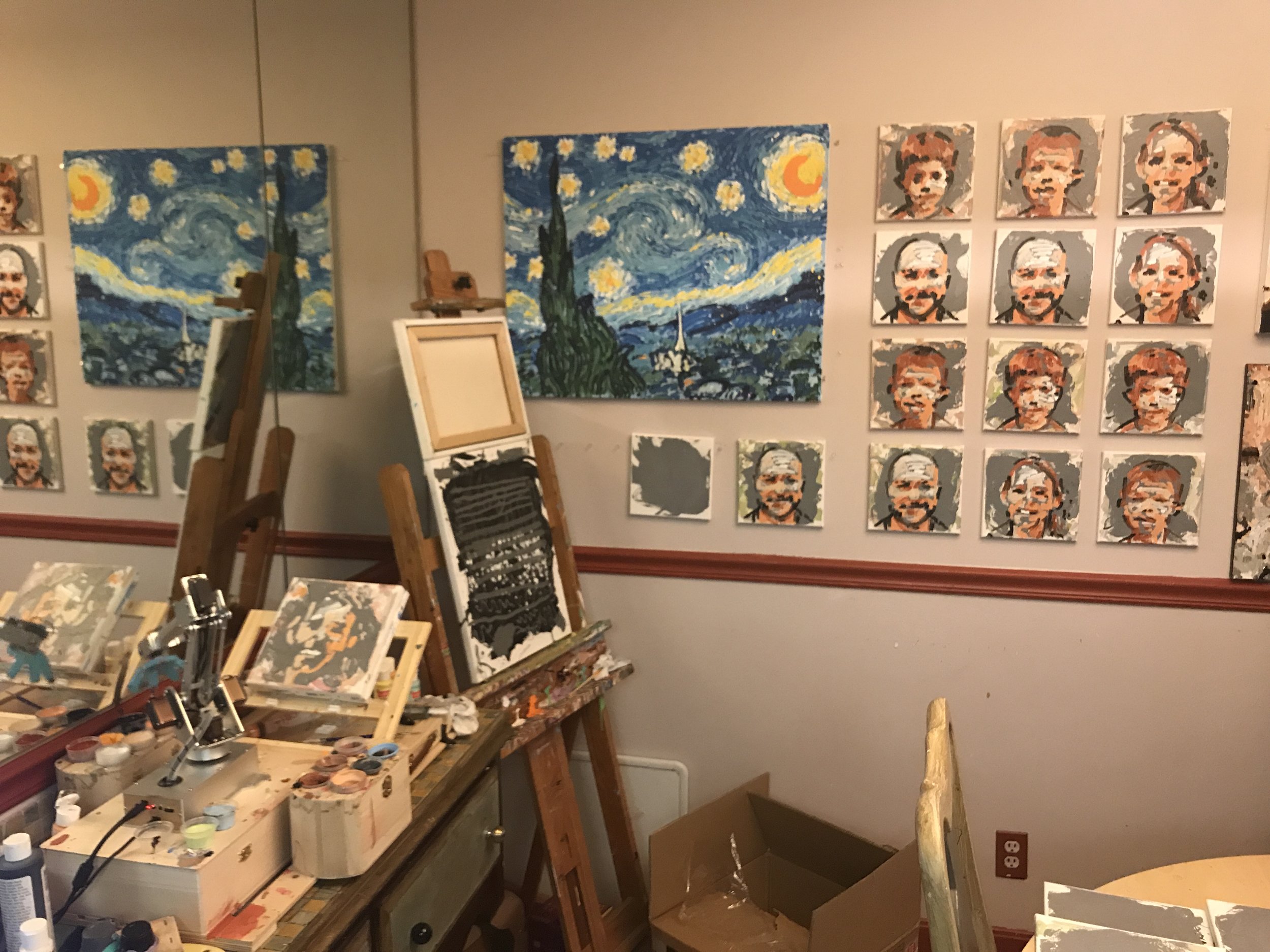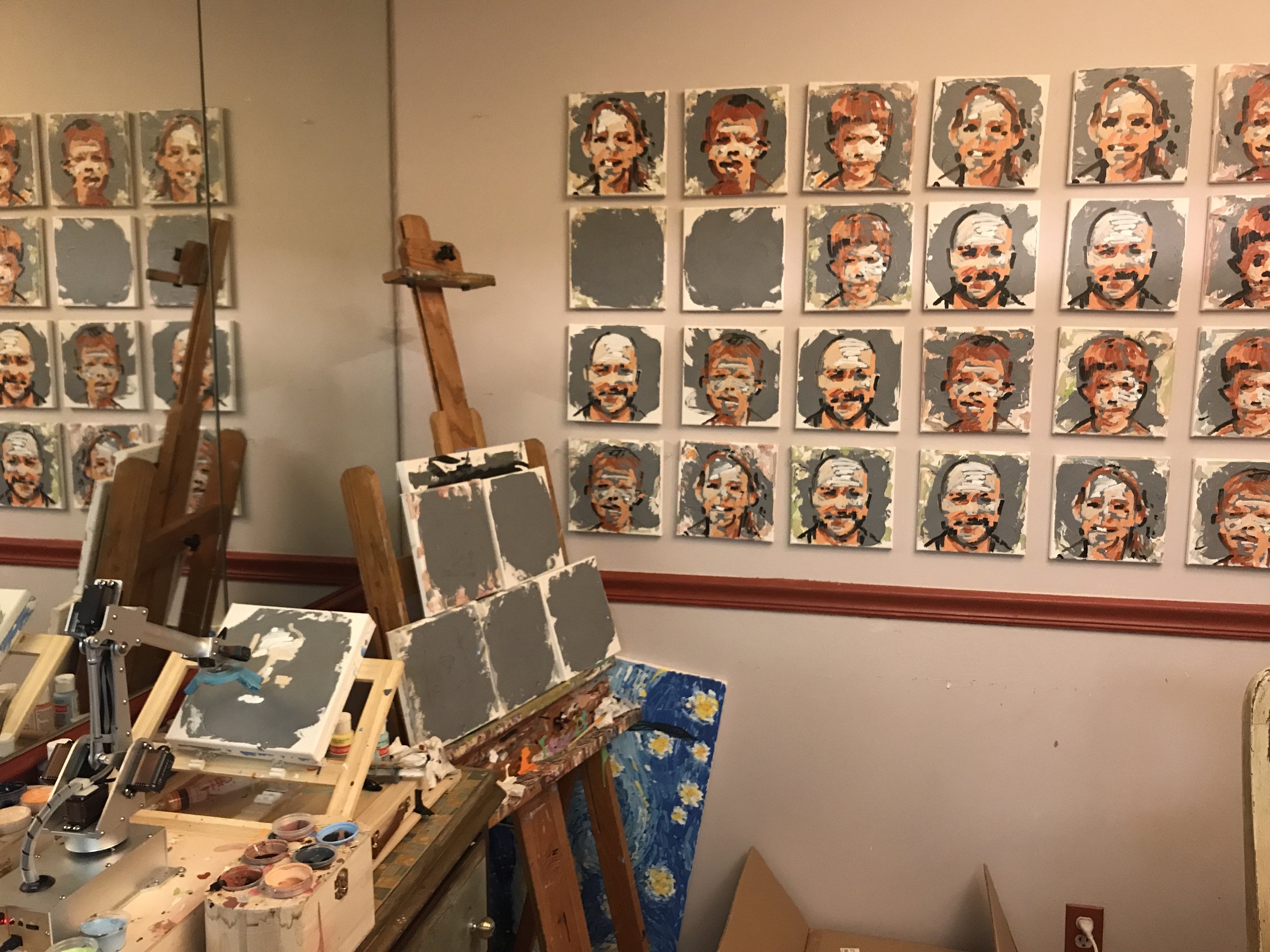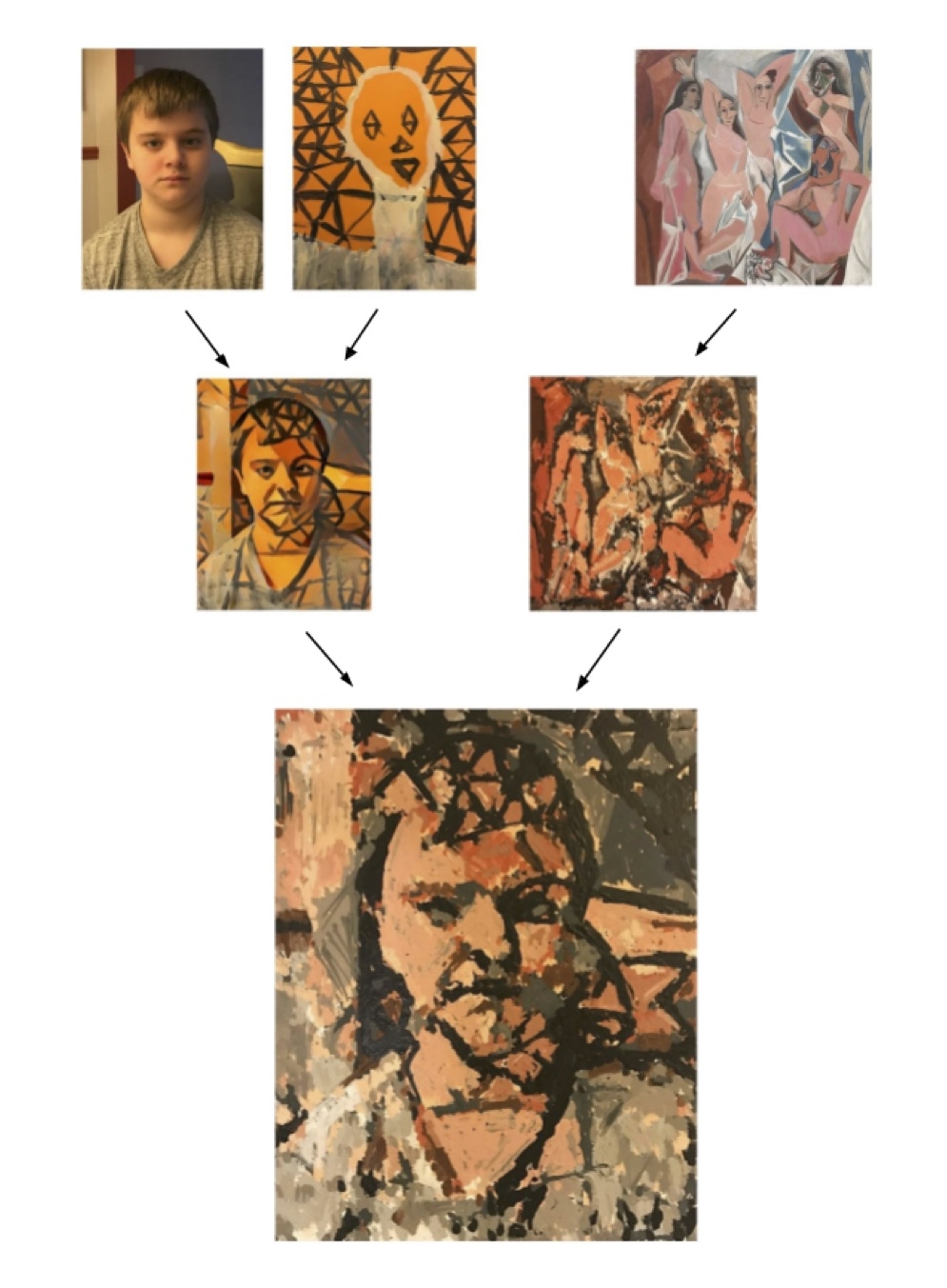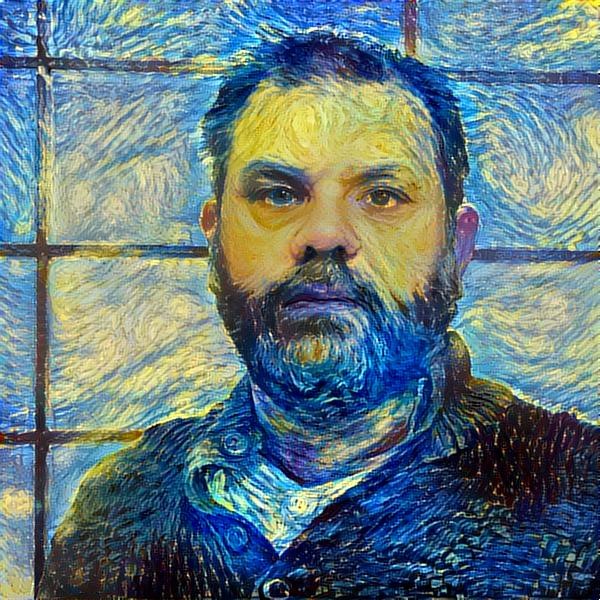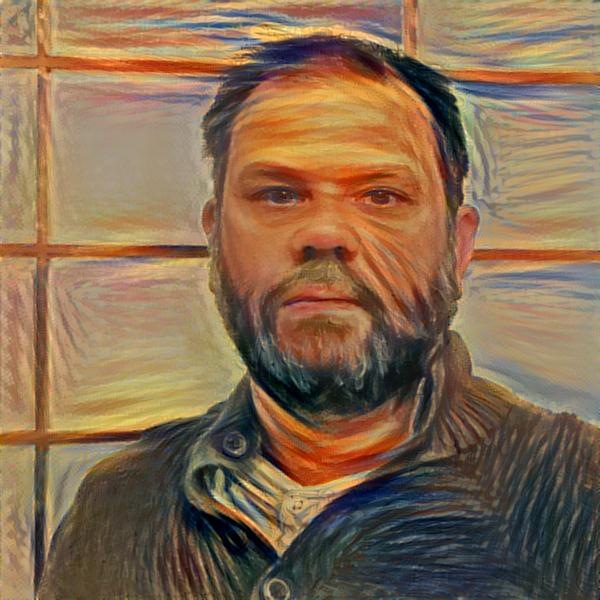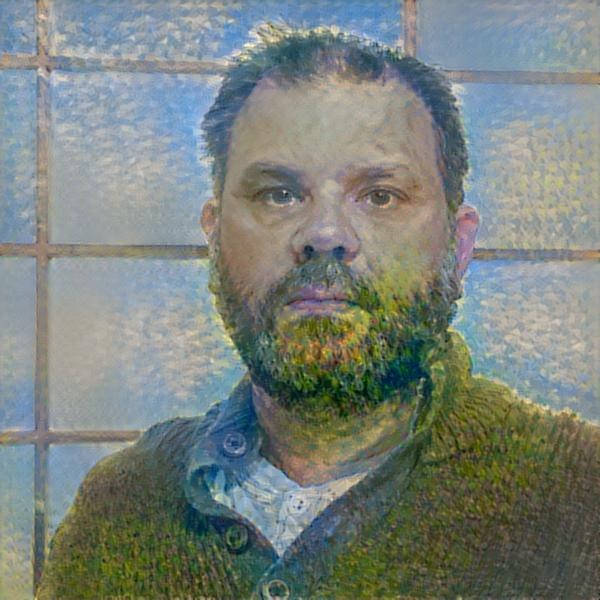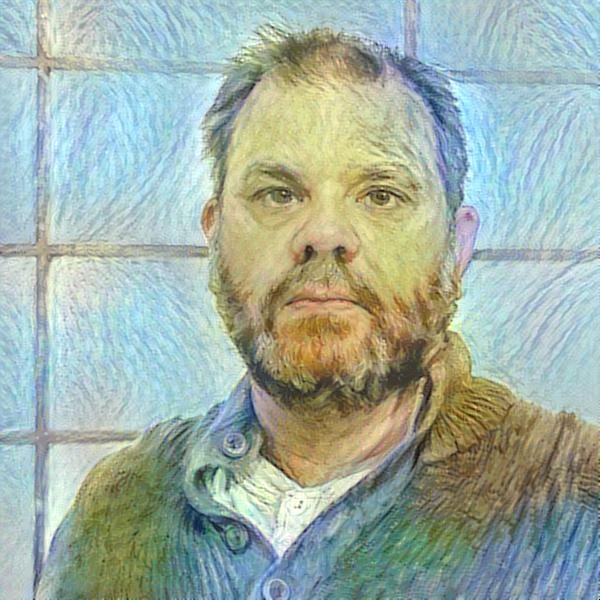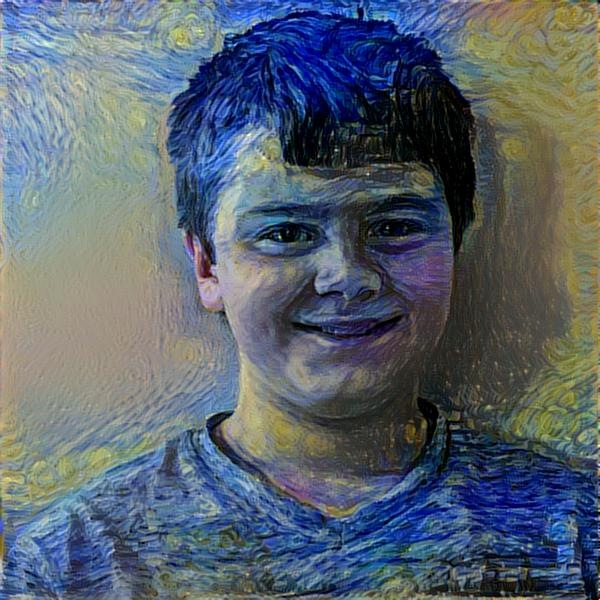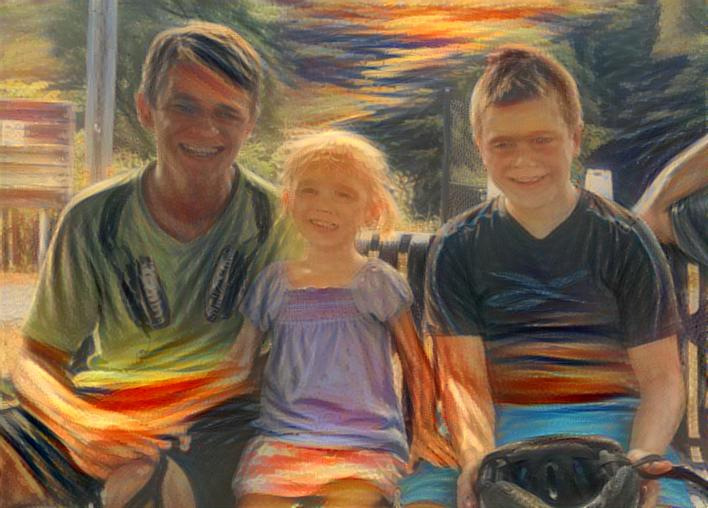Artonomo.us - beginnings of a completely autonomous painting robot.
Artonomo.us is my latest painting robot project.
In this project, one of my robots
1: Selects it’s own imagery to paint.
2: Applies it’s own style with Deep Learning Neural Networks.
3: Then paints with Feedback Loops.
An animated GIF of the process is below…
Artonomo.us is currently working on a series of sixteen portraits in the style above. The portraits were selected from user submitted photos. It will be painting these portraits over the next couple weeks. When done it will select a new style and sixteen new user submitted portraits. If you would like to see more of these portraits, or submit yours for consideration, visit artonomo.us.
Below are the images selected for this round of portrait. We will publish the complete set when Artonomo.us is finished with it…
Pindar
NY Art Critic Jerry Saltz thinks my Painting Robots have Good Taste
New York Magazine's Art Critic Jerry Saltz recently reviewed several AI generated pieces of art including my own. The piece begins at 19:45 in the above HBO Vice video. I was prepared for the worst, but pleased when he looked at this Portrait of Elle Reeve and commented that my robots have "good taste” and that “It doesn’t look like a computer made it.” But he then paused and concluded "That doesn't make it any good." But I loved the review since a couple of years ago the art world did not even consider what I was doing to be art. At least now it is considered bad art. That's progress!
All the AI generated art got roasted, but at least I got what I considered to be the best review of all my colleagues which included some of the world's finest AI generated artwork.
Pindar
New Art Algorithm Discovered by autonymo.us
Have started a new project called autonymo.us where I have let one of my painting robots go off on its own. It experiments and tries new things, sometimes completely abstract, other times using a simple algorithm to complete a painting. Sometimes it uses different combinations of the couple dozens I have written for it.
Most of the results are horrendous. But sometimes it comes up with something really beautiful. I am putting the beautiful ones up at the website autonymo.us. But also thought I would share new algorithms discoveries here.
So the second algorithm we discovered looks really good on smiling faces. And it is really simple.
Step 1: Detect that subject has a big smile. Seriously cause this doesn’t look good otherwise.
Step 2: Isolate background and separate it from the faces.
Step 3: Quickly cover background with a mixture of teal & white paint.
Step 4: Use K-Means Clustering to organize pixels with respect to r, g, b, values and x, y coordinates.
Step 5: Paint light parts of painting in varying shades of pyrole orange.
Step 6: Paint dark parts of painting in crimsons, grays, and black.
A simple and fun algorithm to paint smiling portraits with. Here are a couple…
Are My Robots Finally Creative?
After twelve years of trying to teach my robots to be more and more creative, I think I have reached a milestone. While I remain the artist of course, my robots no longer need any input from me to create unique original portraits.
I will be releasing a short video with details shortly, but as can be seen in the slide above from a recent presentation, my robots can "imagine" faces with GANs, "imagine" a style with CANs, then paint the imagined face in the imagined style using CNNs. All the while evaluating its own work and progress with Feedback Loops. Furthermore, the Feedback Loops can use more CNNs to understand context from its historic database as well as find images in its own work and adjust painting both on a micro and macro level.
This process is so similar to how I paint portraiture, that I am beginning to question if there is any real difference between human and computational creativity. Is it art? No. But it is creative.
Artobotics - Robotics Portraits
While computational creativity and deep learning has become a focus of many of my robotics paintings, sometimes I just like to make something I am calling artobotic paintings, or artobotics.
With these paintings I have one of my robots paint relatively quick portraits, but not just one, dozens of them. The following is a large scale portrait of a family that was painted by one of my robots over the course of a week.
Robot Art 2017 - Top Technical Contributor
CloudPainter used deep learning, various open source AI, and some of our own custom algorithms to create 12 paintings for the 2017 Robot Art Contest. The robot and its software was awarded the Top Technical Contribution Award while the artwork it produced recieved 3rd place in the aesthetic competition. You can see the other winners and competitors at www.robotart.org.
Below are some of the portraits we submitted.
Portrait of Hank
Portrait of Corinne
Portrait of Hunter
We chose to go an abstract route in this year's competition by concentrating on computational abstraction. But not random abstraction. Each image began with a photoshoot, where CloudPainter's algorithms would then pick a favorite photo, create a balanced composition from it, and use Deep Learning to apply purposeful abstraction. The abstraction was not random but based on an attempt to learn from the abstraction of existing pieces of art whether it was from a famous piece, or from a painting by one of my children.
Full description of all the individual steps can be seen in the following video.
NVIDIA GTC 2017 Features CloudPainter's Deep Learning Portrait Algorithms
CloudPainter was recently featured in NVIDIA's GTC 2017 Keynote. As deep learning finds it way into more and more applications, this video highlight some of the more interesting applications. Our ten seconds comes around 100 seconds in, but I suggest watching the whole thing to see where the current state of the art in artificial intelligence stands.
Our First Truly Abstract Painting
Have had lots of success with Style Transfer recently. With the addition of Style Transfer to some of our other artificially creative algorithms, I am wondering if cloudpainter has finally produced something that I feel comfortable calling a true abstract painting. It is a portrait of Hunter.
In one sense, abstract art if easy for a computer. A program can just generate random marks and call the finished product abstract. But that's not really an abstraction of an actual image, its the random generation of shapes and colors. I am after true abstraction and with Style Transfer, this might just be possible.
More details to come as we refine the process, but in short the image above was created from three source images, seen in the top row below, and image of Hunter, his painting, and Picasso's Les Demoiselles d Avignon.
Style Transfer was applied to the photo of Hunter to produce the first image in the second row. The algorithm tried to paint the photo in the style of Hunter's painting. The second image in the second row is a reproduction of Picasso's painting made and recorded by one of my robots using many of its traditional algorithms and brush strokes by me.
The final painting in the final row was created by cloudpainter's attempt to paint the Style Transfer Image with the brush strokes and colors of the Picasso reproduction.
While this appears like just another pre-determined algorithm that lacks true creativity, the creation of paintings by human artists follow a remarkably similar process. They draw upon multiple sources of inspiration to create new imagery.
The further along we get with our painting robot, I am not sure if we are less creative than we think, or computers are much more so than we imagined.
Hunter's Portrait
Inspired by our trip to the National Portrait Gallery, we started thinking to ourselves, what's so impressive about making our robot's paint like a famous artist. Sure they are inspirational and a lot can be learned from them, but when you think about it, people are more interested in the art of their loved ones.
So this morning, Hunter and I decided to do quick portraits of each other and then run the portraits through deep neural nets to see how well they applied to a photo we took of each other. As soon as we started, Corinne joined in so here is obligatory photo of her helping out.
Also in the above photo you can see my abstract portrait in progress.
Below you can see the finished paintings and how they were applied to the photos we took. If you have been following this blog recently, you will know that the images along the top are the source images from which style is taken and applied to the photos on the left. This is all being done via Style Transfer and TensorFlow. Also I should note that the painting on left is mine, while Hunter's is on right.
Most interesting thing about all this is that the creative agent remains Hunter and I, but still something is going on here. For example even though we were the creative agents, we drew some of our stylistic inspiration from other artist's paintings that we saw at the National Portrait Gallery yesterday. Couldn't a robot do something similar?
More work to be done.
Applying Style Transfer to Portraits
Hunter and I have been focusing on reverse engineering the three most famous paintings according to Google as well as a hand selected piece from the National Gallery. These art works are The Mona Lisa, The Starry Night, The Scream, and Woman With A Parasol.
We also just recently got Style Transfer working on our own Tensor Flow system. So naturally we decided to take a moment to see how a neural net would paint using the four paintings we selected plus a second work by Van Gogh, his Self-Portrait (1889).
Below is a grid of the results. Across the top are the images from which style was transferred, and down the side are the images the styles were applied to. (Once again a special thanks to deepdreamgenerator.com for letting us borrow some of their processing power to get all these done.)
It is interesting to see where the algorithm did well and where it did little more than transfer the color and texture. A good example of where it did well can be seen in the last column. Notice how the composition of the source style and the portrait it is being applied to line up almost perfectly. Well as could be expected, this resulted in a good transfer of style.
As far as failure. it is easy to notice lots of limitations. Foremost, I noticed that the photo being transferred needs to be high quality for the transfer to work well. Another problem is that the algorithm has no idea what it is doing with regards to composition. For example, in The Scream style transfers, it paints a sunset across just about everyone's forehead.
We are still in processing of creating a step by step animation that will show one of the portraits having the style applied to it. It will be a little while thought cause I am running it on a computer that can only generate one frame every 30 minutes. This is super processor intensive stuff.
While processor is working on that we are going to go and see if we can't find a way to improve upon this algorithm.
Talked Portraiture With Chuck Close at the White House
As you know, I was invited to White House for SXSL. I have many good pictures of what was a real fun day. But I wanted to share this one in particular 'cause I am still processing how awesome meeting Chuck Close was.
So when I saw Chuck Close on the South Lawn, I realized that I had to introduce myself. As an artist he has always been a favorite, if not the favorite, though its sort of impossible to rank something like that. I have long imitated many of his concepts in my own art. I even designed my fourth robot to fit large canvases so it could paint portraits on the scale of his work.
While I wasn't expecting to be starstruck when I went up to introduce myself, I was. I didn't know what to say so I just told him I was a portrait artist to which he replied that he was sorry to hear that as it was a horrible line of work to be in. Then we chatted about portraiture briefly where he made a couple of other jokes before asking to see some of my work. I wasn't expecting that, either his interest in my work, or his compassionate humor. I showed him some portraits of my family on my phone, said my thanks for taking the time to talk with me, then went on my way.
I wanted to talk to him longer but at same time didn't want to be a harasser.
Photo Submission Guidelines and Quick Update
So about half of you backers have responded to the questionnaire and sent in photos. Some followed the guidelines I gave in earlier post, but most of you just ignored them. So then I realized that you all don't want me telling you what to submit.
Send in whatever you want. I was convinced that some of the submission below wouldn't work, but then they came out great! So what do I know. If you do send in a non-standard image, just have patients with my robots early attempts. If my existing algorithms have a hard time with the image, we will just try painting a second one. It will be up to you.
Schedule wise, I have already begun painting some portraits that are needed for Christmas presents. Will have a schedule of when you can expect your paintings as soon as some more questionnaires come back. If you have not filled out the questionnaire I sent out, please do. If you need portrait as a Christmas present, please tell me as soon as possible. The slots are just about full but if its really important to you, its really important to me and I will see what I can do.
Crowdsourced Einstein
This crowdsourced portrait of Einstein turned out to be a lot more popular than I was expecting. Got written up here which resulted in all sorts of attention. Though I am of course a big fan, I didn't realize that Einstein was such a popular media figure.
Crowdsourced Musicians
This triptych was painted by hundreds of people over 6 weeks. The time lapse video shows the final two weeks when the third canvas was being worked on. It is of three Washington D.C. Street Performers that calmed my crying daughter with a soothing rendition of Killing Me Softly.
Crowdsourced Portrait of Mother
Crowdsourced Portrait of the Artist's Mother entry for Outwin Boochever Portrait Competition 2016.
Crowdsourced Gandhi
This portrait came together much faster than anticipated. I originally planned to keep it up all week, but after only a day of painting it looked beautiful, so I decided to pull it out of the robot. One of the rare aspects of this painting is that it escaped vandalism.
Crowdsourced Queen Elizabeth
Stopped this painting after the second day. Had originally planned to have it up all week, but it just got too interesting. I would love to find out who added the collar. It is so spooky, so much so, I decided it was done.
Just Received this email about the collar:
"I was who painted the spooky collar on Queen Elizabeth portrait, also paint the face, clothing and FSM (flying spaghetti monster) in the top right. I would like to add that the necklace was a kind of futuristic necklace.
I love your artistic idea is fantastic from Spain I can paint a painting in America. - C Mas"
Crowdsourced Buzz Aldrin
Somewhere in Germany, the imagination of an artist was captured by this portrait meant to commemorate Buzz Aldrin's moon landing. The artist's name was R. Meyer. Where others saw an American Hero, R. Meyer saw a muscle bound psychopath. No matter how many times people tried to paint over his strokes, R. Meyer would return and repaint his vision. Over and over, back and forth, R. Meyer would not be dissuaded, until finally it was time for us to move on to the next painting.
R. Meyer was triumphant and his interpretation won out over all others.
Crowdsourced Self Portrait
I have done self portraits with my robot before, but this is the first crowd sourced one. Left it up for a number of days for people from around the world to work on it. Also, my youngest son did a significant amount of work on it.












